One of the most confusing things about WordPress errors is when they’re caused by something you can’t even see. The .htaccess file is hidden by default, but it quietly controls important parts of your website like redirects, permalinks, and access rules.
We’ve seen users struggle with strange issues like broken links, blank pages, or login problems. In many cases, a small change in this file was the root of the issue.
Because it’s not always easy to locate or edit, beginners often feel stuck. The good news is you don’t need to be a developer to fix it.
In this guide, we’ll show you how to find your .htaccess file, fix common problems, and safely get your WordPress site working the way it should.
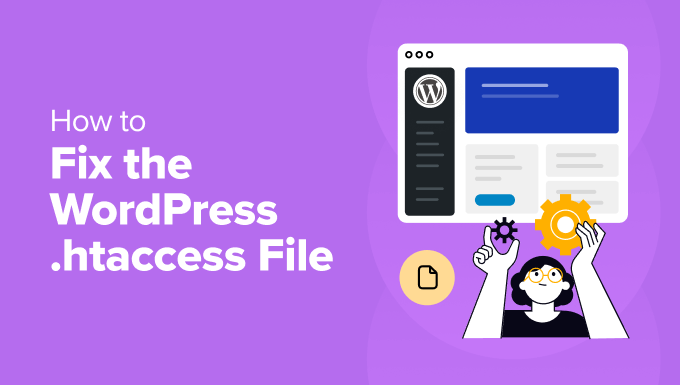
Here is a quick overview of everything we will cover in this guide. You can click the links below to jump to any section:
- What Is the .htaccess File?
- How to Tell If Your .htaccess File Is Corrupted
- How to Access and Fix .htaccess File in WordPress
- Common Issues to Fix in WordPress .htaccess File
- FAQs About the .htaccess File in WordPress
- Additional Resources for the WordPress .htaccess File
What Is the .htaccess File?
The .htaccess file is a hidden file that controls how your server handles requests on your WordPress site. Think of it like a traffic controller that quietly directs links, visitors, and access rules behind the scenes.
It helps create clean and readable URLs for your pages. Instead of long strings of numbers, you get friendly links like yoursite.com/about-us.
The file can also protect your site by blocking unwanted IP addresses or restricting access to certain folders. Many plugins rely on it to enable caching and speed up your website.
We’ve seen cases where a small change in this file caused links to break or plugins to stop working. That’s why it’s helpful to understand what this file does and how to fix it if something goes wrong.
Next, we’ll show you how to tell if your .htaccess file might be causing problems.
How to Tell If Your .htaccess File Is Corrupted
The .htaccess file can sometimes get corrupted without warning. This usually happens because of a plugin conflict, a small mistake during editing, or a server hiccup.
Here are a few common signs we’ve seen that point to a broken or missing .htaccess file:
- Broken links: When visitors click a link but land on a 404 page or see strange errors instead of your content.
- White screen of death: Your website shows a completely blank page with no error message or content.
- Plugins not working properly: Some plugins depend on this file to work correctly. If it’s corrupted, you may notice missing features or layout issues.
If you’re seeing any of these issues, don’t worry. In the next section, we’ll show you step-by-step how to access and safely fix the .htaccess file.
How to Access and Fix .htaccess File in WordPress
You’ll find the .htaccess file in the root directory of your WordPress website. There are a few different ways to open and edit it, depending on what tools you’re comfortable with.
You can access it through your hosting provider’s cPanel using File Manager, through an FTP client like FileZilla, or with a plugin inside your WordPress dashboard.
Pro Tip: Always create a backup before editing the .htaccess file. That way, if anything goes wrong, you can quickly restore your site. See our full guide on how to back up your WordPress website.
1. Using File Manager or FTP Client
If you can’t access your WordPress dashboard, then File Manager or FTP is the best way to reach your .htaccess file.
Start by logging into your hosting control panel. In Bluehost, for example, go to your website settings and click the ‘Advanced’ tab to launch cPanel.
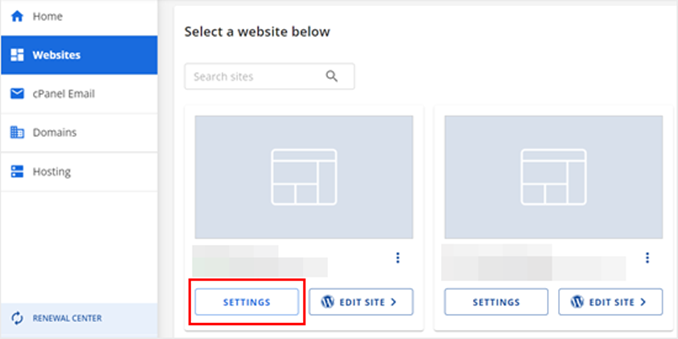
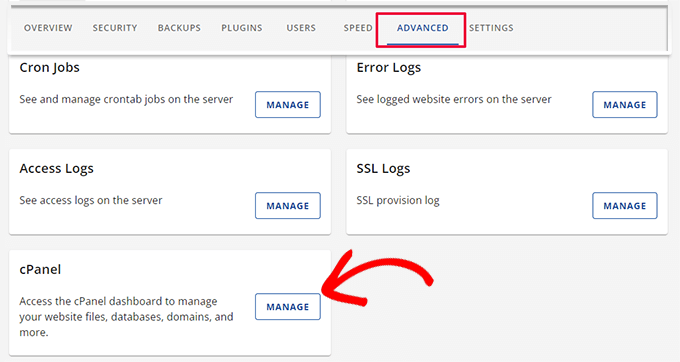
Once inside cPanel, scroll to the ‘Files’ section.
Then, open the ‘File Manager.’
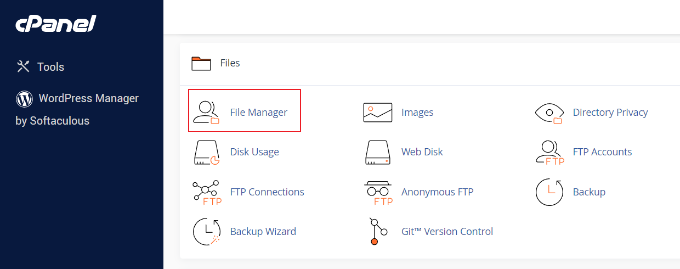
Inside File Manager, open the public_html folder. That’s where you’ll find the .htaccess file.
If it’s hidden, see our guide on how to locate missing .htaccess files.
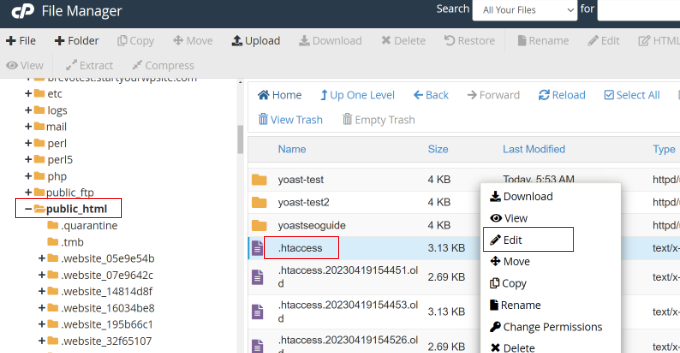
Right-click the file and choose ‘Edit’. A popup will remind you to make a backup.
Click ‘Edit’ again to open the editor.
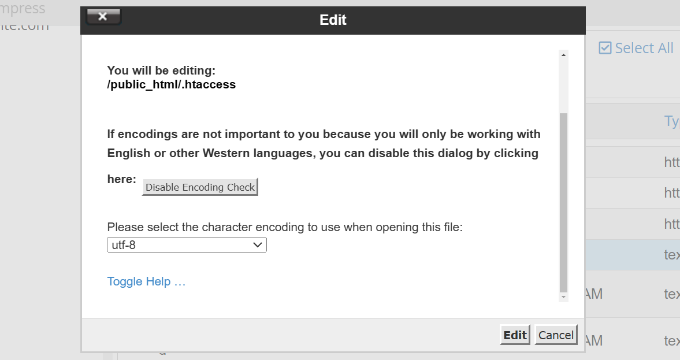
Now you can review the file. Look for any typos, strange characters, or conflicting plugin rules.
Fix what’s needed and click ‘Save.’
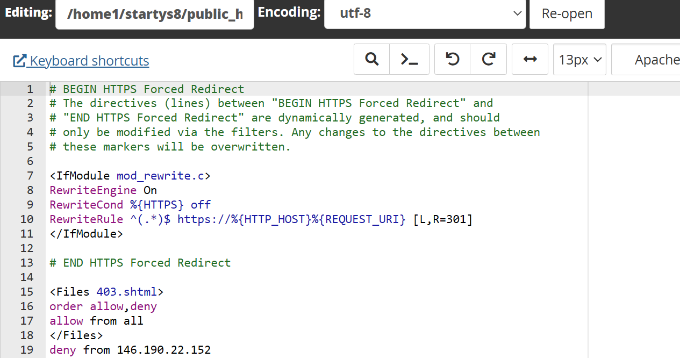
Alternatively, you can use an FTP client like FileZilla, which we’ve used across many sites at WPBeginner.
Just connect to your server, find the .htaccess file in the root directory, and choose ‘View/Edit.’
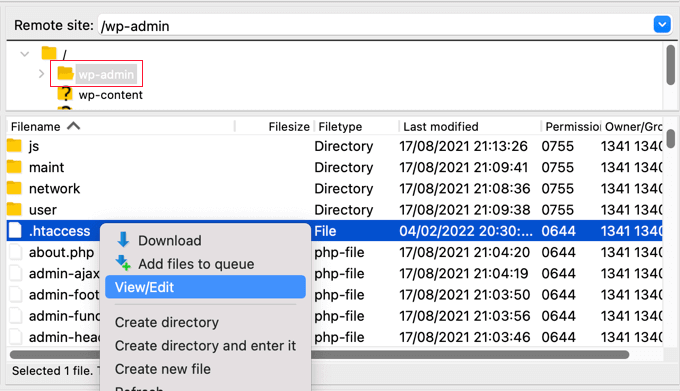
If you’re new to FTP, here’s our step-by-step tutorial on how to use FTP with WordPress.
You can edit the file using a plain text editor like Notepad, then upload it back to your site via FTP.
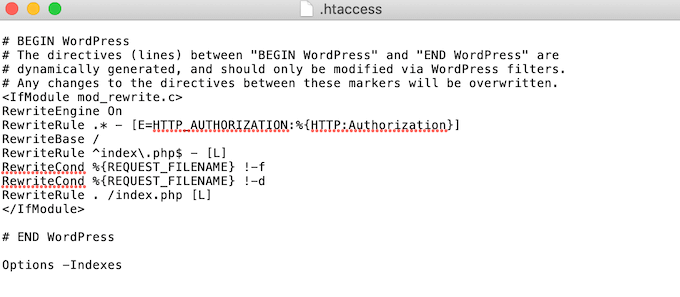
2. Using a Plugin Like AIOSEO
If you can log into your WordPress dashboard, the easiest option is to use the All in One SEO (AIOSEO) plugin. This is the SEO plugin we use on WPBeginner to manage redirects, meta tags, robots.txt, and even .htaccess rules.
For more details, see our complete All in One SEO review
To get started, install and activate the plugin. You’ll see the setup wizard where you can click ‘Let’s Get Started’ and follow the instructions.
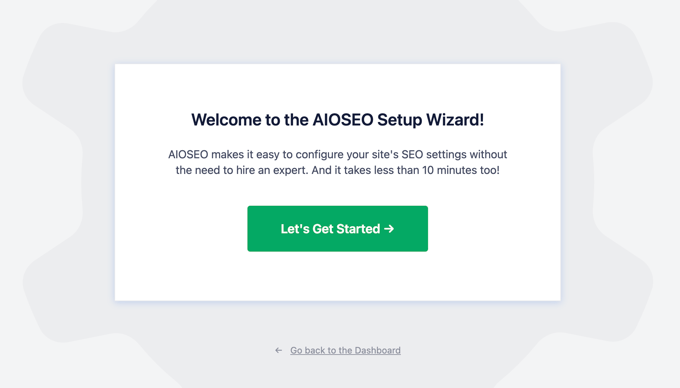
For detailed setup help, see our full tutorial on how to set up AIOSEO correctly.
Next, go to All in One SEO » Tools in your dashboard. Under the ‘.htaccess Editor’ tab, you can view and edit the file directly from your admin panel.
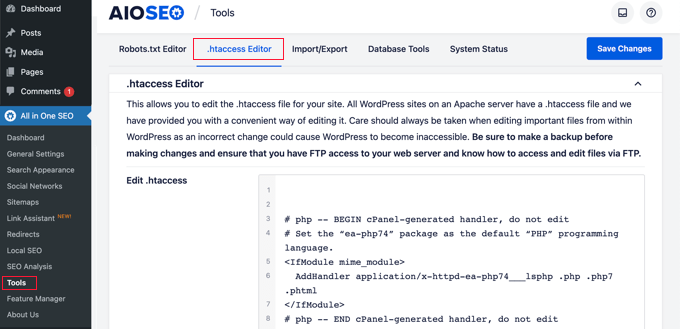
Make your changes, then click ‘Save Changes’. That’s it.
Common Issues to Fix in WordPress .htaccess File
Now that you know how to edit the .htaccess file, let’s go over some common problems it can help solve. These are issues we’ve seen countless users face. Most of them are easier to fix than they seem.
1. Fixing the 500 Internal Server Error
The 500 internal server error is one of the most frustrating problems in WordPress. It usually shows up without any helpful details and can make it look like your site is completely broken.
In many cases, the culprit is a corrupted .htaccess file. To fix it, you’ll need to replace the file with a clean version.
Connect to your site using an FTP client. Locate the existing .htaccess file in the root folder and rename it to something like .htaccess-old. This keeps it as a backup.
Next, create a new file in the same folder and name it .htaccess.
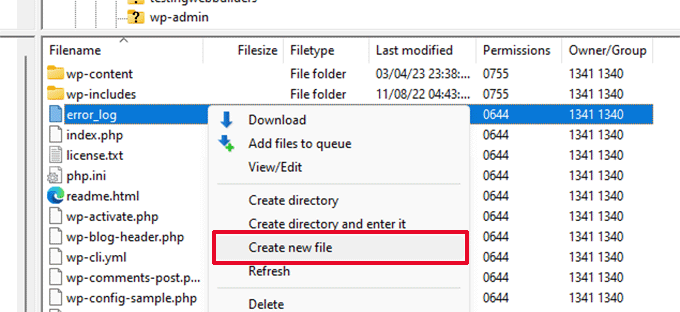
Open the file and paste the following default WordPress rules:
# BEGIN WordPress
<IfModule mod_rewrite.c>
RewriteEngine On
RewriteBase /
RewriteRule ^index.php$ - [L]
RewriteCond %{REQUEST_FILENAME} !-f
RewriteCond %{REQUEST_FILENAME} !-d
RewriteRule . /index.php [L]
</IfModule>
# END WordPress
Save the file and try loading your website again.
This should resolve the error if the old .htaccess was the issue. For more help, see our guide on fixing the 500 internal server error.
2. Fixing the “Too Many Redirects” Error
This error happens when your website gets stuck in a redirection loop. It often appears in browsers as “too many redirects” or “redirected too many times.”
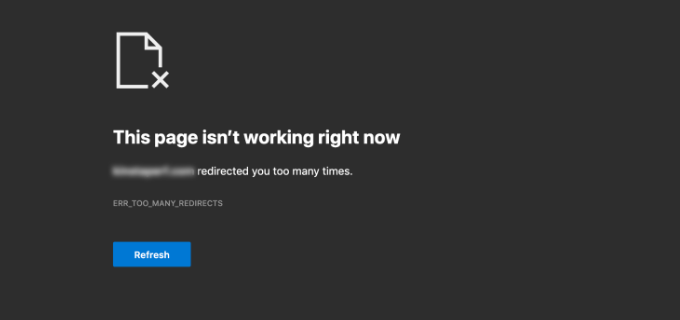
A quick way to fix this is by resetting your .htaccess file. Connect to your site using File Manager or FTP and delete the current file.
Next, go to your WordPress dashboard and visit Settings » Permalinks.
Just click the ‘Save Changes’ button at the bottom. This will regenerate a clean .htaccess file automatically.
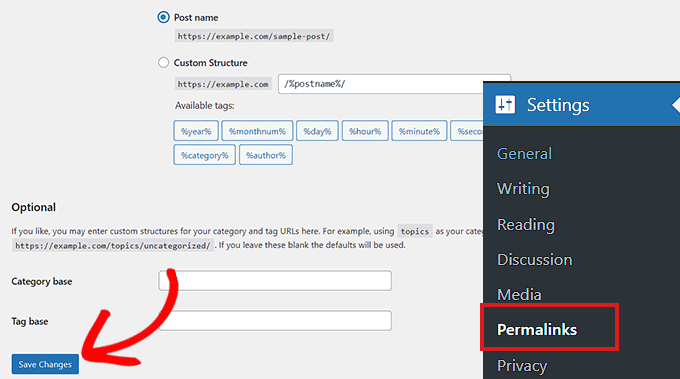
That should stop the redirect loop. If not, see our full guide on how to fix the “too many redirects” issue.
3. Fixing Posts That Return 404 Errors
If your blog posts are showing 404 errors, but your homepage works fine, it usually means the .htaccess file is missing or misconfigured.
One fix is to check the file’s permissions. Connect to your site via FTP, right-click the .htaccess file, and choose ‘File Permissions.’
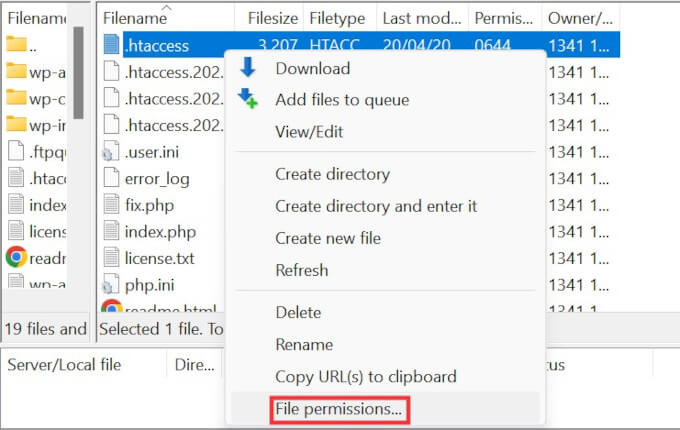
Set the numeric value to 666 so WordPress can temporarily write to the file.
Then save your permalink settings again to refresh the file’s rules.
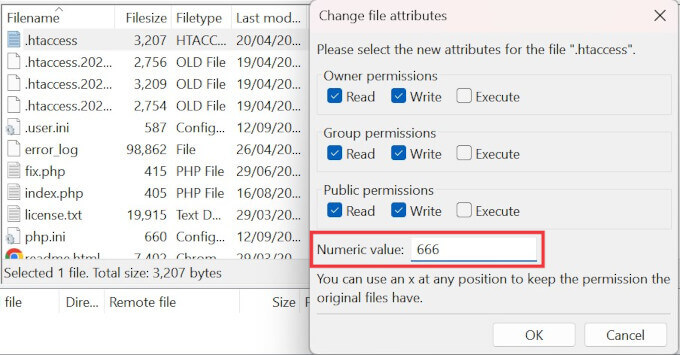
After the 404 errors are gone, you can reset the permissions back to a more secure setting, like 644. For a full guide, see how to fix WordPress posts returning 404 errors.
There are other WordPress errors that may involve the .htaccess file, but these are the most common ones we see. For a broader list, check out our roundup of common WordPress errors and how to fix them.
FAQs About the .htaccess File in WordPress
What happens if I delete the .htaccess file in WordPress?
If you delete the .htaccess file, your site may start showing 404 errors, redirects may break, and certain security or performance settings will stop working. WordPress will usually regenerate the file if you visit Settings » Permalinks and click ‘Save Changes.’
Can I edit the .htaccess file from the WordPress dashboard?
Not directly. WordPress doesn’t provide a built-in way to edit .htaccess files from the dashboard. You’ll need to use a plugin, FTP client, or your hosting provider’s File Manager.
Is it safe to manually edit the .htaccess file?
Yes, but you should be careful. A small mistake can break your site. Always make a backup before editing the file manually.
Why does WordPress keep overwriting my .htaccess file?
WordPress updates the .htaccess file whenever you change permalink settings or when plugins with rewrite rules are activated. To prevent this, you can move custom rules outside the default WordPress block or use a plugin to manage your rules.
Where is the .htaccess file located?
The .htaccess file is located in the root directory of your WordPress site, usually the same folder that contains wp-config.php and wp-content.
Additional Resources for the WordPress .htaccess File
Want to learn more about using the .htaccess file to protect and optimize your WordPress site? These helpful tutorials walk you through practical use cases, advanced tips, and related fixes:
- How to Stop WordPress From Overwriting the .htaccess File
- How to Limit Access by IP to Your wp-login.php File in WordPress
- Most Useful .htaccess Tricks for WordPress
- How to Redirect a Page or URL in WordPress
- Fixing the Maximum Execution Time Exceeded Error in WordPress
We hope this guide helped you safely fix your .htaccess file. For more help keeping your site healthy, check out our ultimate WordPress maintenance guide and our list of the best WordPress support agencies.
If you liked this article, then please subscribe to our YouTube Channel for WordPress video tutorials. You can also find us on Twitter and Facebook.





Olaf
The .htaccess file is a very powerful tool, and it can sometimes work wonders if you hit a limit, for example, in PHP. On the other hand, it can also cause headaches. It’s always a good idea to have this file backed up from when the site was working properly because, honestly, this file doesn’t change that often. In my opinion, a backup can solve 90% of the issues with this file. And if someone is making changes to it, I recommend two things. First, don’t write anything between # BEGIN WordPress and # END WordPress, because that section is overwritten by WordPress, and second, make sure to add comments. This will help anyone who inherits the site understand the modifications you’ve made to this file.
Oyatogun Oluwaseun Samuel
Thank you for this resource on fixing the .htaccess file. It can be hard to tell when dealing with htaccess issue but this article brought to the fore, pointers that can help you recognise faulty htacess fie. Your attention to detail and clear explanation will undoubtedly help many wordpress users like me resolve htaccess issues effectively. Great job!
Kzain
I once had a complete meltdown because my images wouldn’t load, and it turned out to be a tiny mistake in the .htaccess file. Thanks for this clear guide, WPBeginner! It’s definitely a lifesaver for those moments when your website suddenly acts wonky
WPBeginner Support
Glad our guide was able to help!
Admin
Jiří Vaněk
I would like to ask. Occasionally, on shared hosting, my website would crash with a 500 error because the .htaccess file contained a directive that was forbidden on the shared server. This caused the website to encounter this error. Since I didn’t know which directive was causing this, I had to contact the server administrator. They usually identified the directive for me and often provided the server’s error log as well. Is it possible that I could discover the same log or error in .htaccess myself if I enable debug mode and debug log? I feel like debug log also stores server error logs. Or am I mistaken?
WPBeginner Support
If your server hosting has error logging then that could give you an idea of what caused the specific error on your site.
Admin
Jiří Vaněk
Yes, it does, but I always have to ask the server provider to send me logs in case of issues because I don’t have a control panel to view logs myself. This can be time-consuming for both me and them, as they have to download and send me the logs. That’s why I wanted to try the method of using debug logs and debug mode.
Yunus Rahman
Excellent guide! The .htaccess file can be intimidating, but this tutorial makes it easy to understand and fix common issues.
I appreciate the step-by-step instructions and examples, which make it simple to follow along. WPBeginner always delivers high-quality content, and this post is no exception.
Thanks for helping WordPress users troubleshoot and fix .htaccess file problems – this will come in handy for many.
Mrteesurez
This is helpful, thanks.
No one can deny the importance of htaccess file in a website as it is used to fix errors and correct many issues in websites.
I use Apache web server, any time I lost an htaccess, I generated another one following your guide.
But I like to ask: I see that AIOSEO is used to access htaccess file, is it possible to edit and update htaccess from a website by plugin or otherwise without needing to log into hosting or Cpanel ?
WPBeginner Comments
While there are some plugins out there that do this, there is a bit of added security by not allowing the ability to edit the .htaccess file directly in a WordPress editor.
Also, if a mistake such as a typo is made, this could bring down the site and the admin would be inaccessible. The file manager or FTP is still usable when the site is down.
We recommend using a file manager or FTP to edit the .htaccess file.
Mrteesurez
Thanks for this valuable feedback! You’ve highlighted an important point about the risks involved in directly editing the .htaccess file through the editor. I completely agree that the added security of using a file manager or FTP is crucial. It’s easy to overlook how a simple typo could bring down an entire site, making the admin area inaccessible. By using a file manager or FTP, you can maintain control even if something goes wrong, ensuring that you can quickly fix any issues. I see this approach will not only protects my site but also provides a safer way to handle critical files. I like your your recommendation and will also be helpful for anyone looking to maintain the security and stability of their site.